Sound: 









Value: 









(Read about our ratings)
I believe headphones are a gateway to serious hi‑fi—and an extension of it. In-ear monitors let you listen just about anywhere, without the bulk or expense of a traditional loudspeaker setup. While I love my main hi‑fi rig, my preferred method for critical listening is the over-the-ear headphone setup in my home office, partly because of how much time I spend in that space. Most importantly, a good headphone setup can be assembled much less expensively than a similarly performing loudspeaker setup. The icing on the cake is isolation from the outside world.
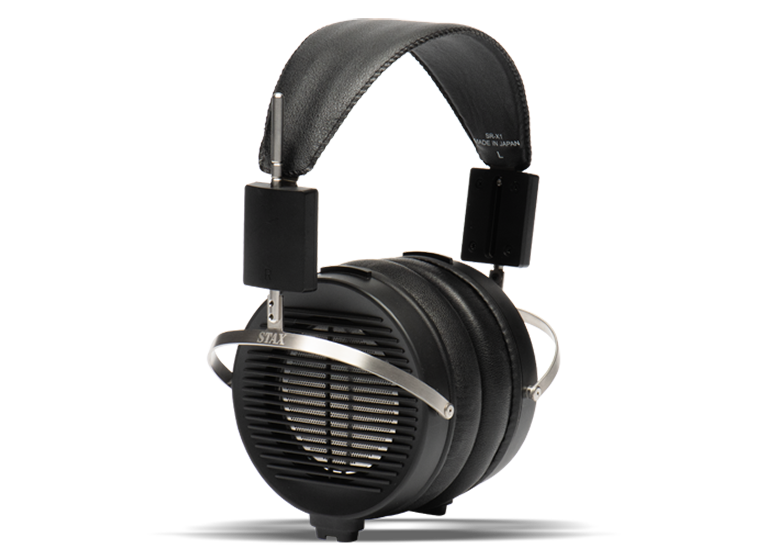
For all these reasons, I was eager to experience the least expensive amplifier-headphone bundle from Stax, which specializes in electrostatic headphones. Stax was founded in 1938, and all of their headphones are still handmade in Japan, where the company is based. In 1960, Stax introduced the first-ever electrostatic headphones, the SR‑1s. Stax has always used the term “earspeakers” for its electrostatic headphones.
The subject of this review, the SRS‑X1000 (US$980, CA$1389, £1095, €1299), includes a pair of SR‑X1 open-back electrostatic headphones (US$535) and the matching SRM‑270S amplifier–energizer (US$445).
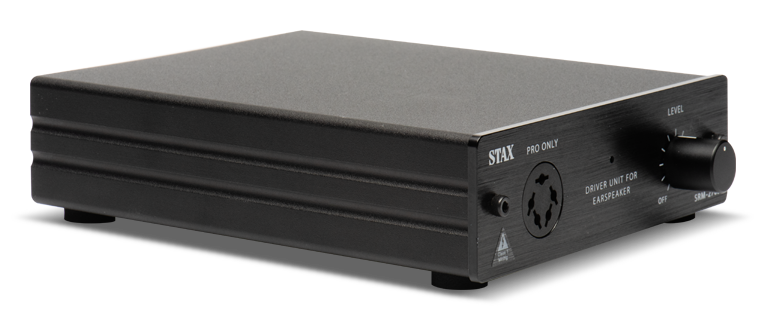
I have always favored planar-magnetic headphones for their weighty bass performance. Electrostatic headphones also have planar diaphragms, but their operating principle is quite different.
With a planar-magnetic design, the sound is produced by a very thin diaphragm situated near an array of magnets. The audio signal passes through a circuit trace etched into the diaphragm, which moves as the signal interacts with the magnetic field.
With electrostatic headphones, the diaphragm has a permanent static charge, but no conductors for the signal, reducing weight significantly. The result is lower distortion and extended high-frequency response. The SR-X1s’ specified frequency response is 7Hz–41kHz (no deviation spec is given).
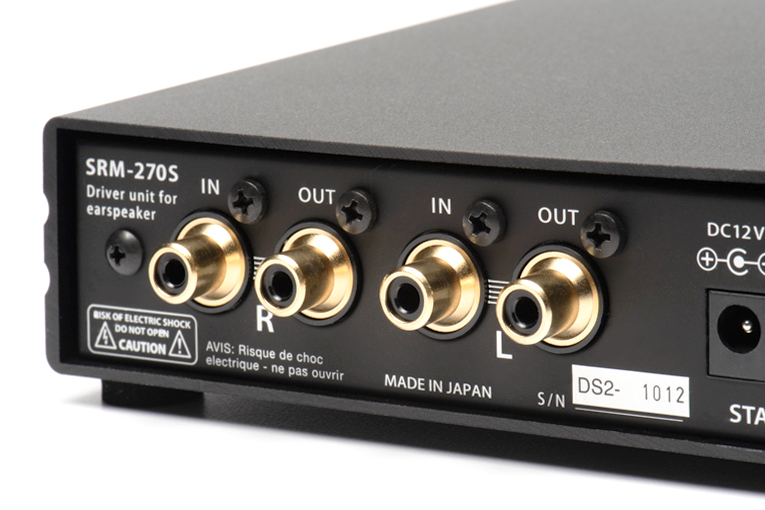
All electrostatic headphones require a purpose-built amplifier–energizer that can supply a high-voltage static charge for the diaphragm and send an amplified signal to the electrodes surrounding the diaphragm.
The ’phones
Sporting medium-sized, circular earcups, the SR-X1s are very light, weighing only 234g. By comparison, my Audeze LCD‑2 Closed-Back headphones weigh 612g. Stax uses metal for the arc assembly and integrates the head pad with the arc to minimize resonances.
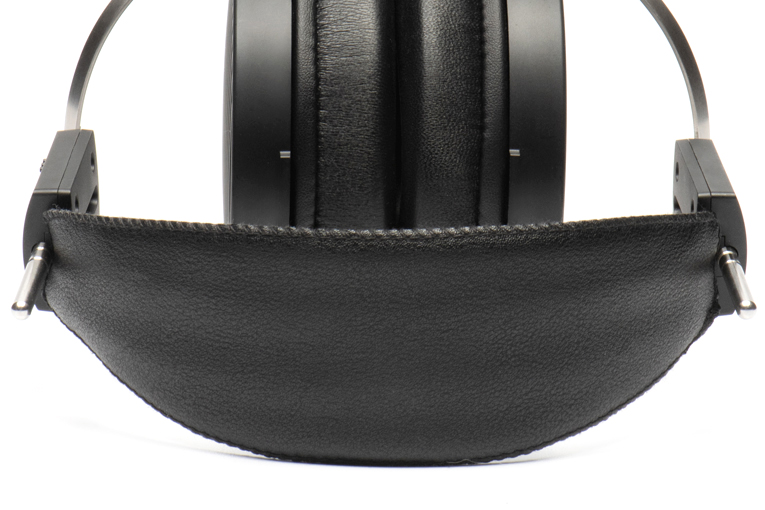
The areas of the earpads that touch the listener’s skin are made from sheepskin, with memory foam behind; the supporting areas are made from artificial leather. While these materials have a premium look and feel, I felt some pressure on my ears because the pads weren’t thick enough to keep the front of the transducers from pressing against my earlobes. This caused slight discomfort during long listening sessions, but only after several hours of use. I found the clamping force on my head firm yet gentle, with slightly more pressure below my ears. I never felt that the headphones would fall off my head if I bent down or moved too quickly.
The ’phones come supplied with 2.5m (8.2′) detachable cables with three parallel oxygen-free copper (OFC) cores for each channel. The strands, six in total, are arranged in a flat and wide format; this arrangement minimizes capacitance, Stax says. On the headphone end, the cables have clearly marked L and R labels. A five-pin plug on the opposite end fits into the amplifier–energizer.
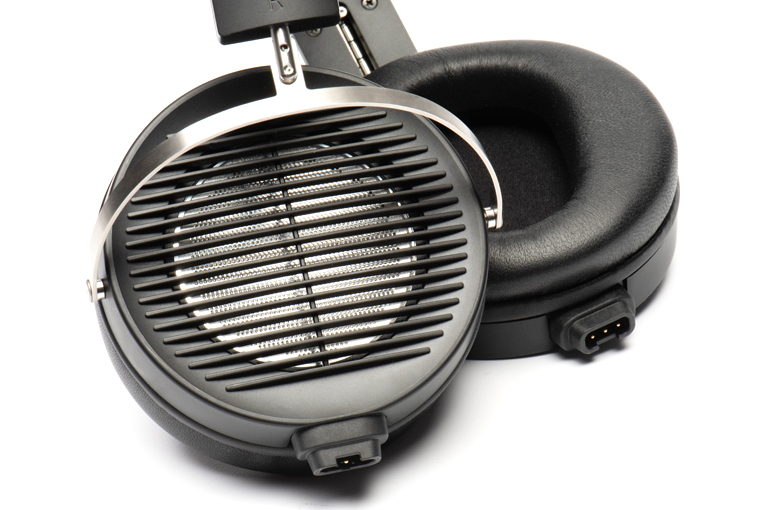
The electrostatic transducers are push-pull devices, each consisting of two parallel, fixed electrodes and a high-polymer film diaphragm, just a few microns thick, suspended between the electrodes. The diaphragm is energized with a 580V DC biasing voltage from the amplifier-energizer. The audio signal is applied to the electrodes, and the alternating signal interacts with the charged diaphragm, causing it to vibrate.
The amplifier
Finished in black, the SRM‑270S amplifier–energizer has an extruded aluminum case to aid heat dissipation. It measures 5.2″W × 1.5″H × 6″D, excluding protruding parts like connectors and feet, and weighs 1.18 pounds (540g). On the left side of the 3mm-thick aluminum front panel is a five-pin output connector that delivers the audio signal to the electrodes along with 580V bias voltage for energizing the diaphragm. On the far right is a similarly sized volume knob. On the rear are one pair of single-ended line-level inputs and one pair of line-level outputs (all RCA); the latter can be useful if you want to send the signal on to a power amp for out-loud listening. On the far right is an inlet for the supplied 12V power adapter.
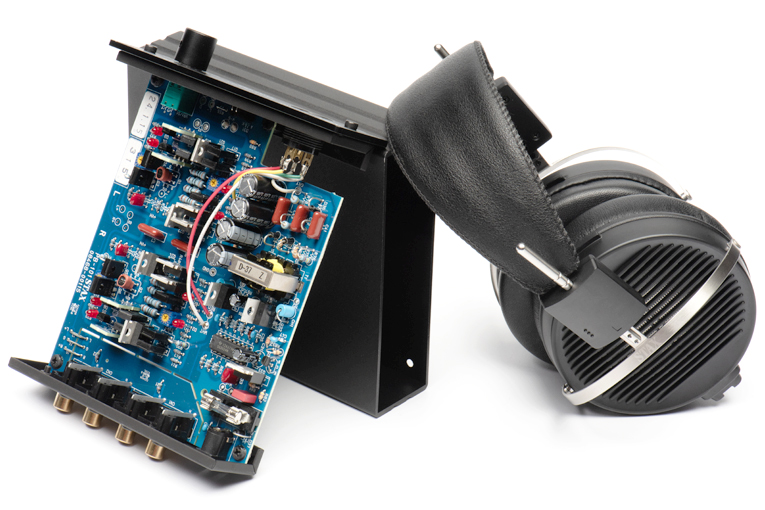
A (semi) portable option
Listeners who want to use the SR‑X1s on the go can mate the ’phones with Stax’s SRM‑D10 II DAC-energizer-headphone amp (available separately for US$980, or as a bundle with the SR‑X1s for US$1340). The SRM‑D10 II has a 3.5mm analog line-level input and a USB-C port. Via USB, it can accept PCM audio up to 32-bit/384kHz and up to DSD256. Battery life is rated at 4.5 hours for the analog input and 3.5 hours for digital. The unit has a confidence-inspiring aluminum shell. Measuring 3″W × 1.3″H × 5.7″D and weighing 1 pound, the SRM‑D10 II is better suited for trips to the coffee shop than walks around the park.
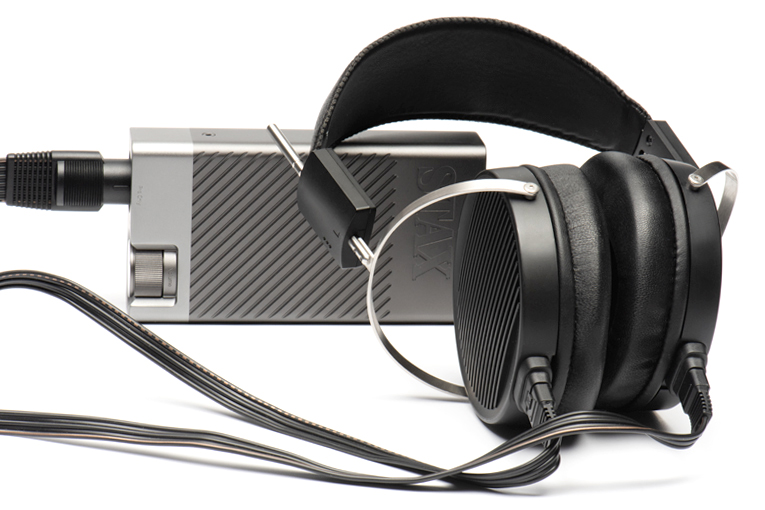
This portable bundle also makes a great office system—just connect the SRM‑D10 II to the USB port of your laptop or smart device, and you have everything you need to listen to music. I connected the unit to my iPhone 16 Pro and 13″ MacBook Air and had no issues playing music from the Tidal and Roon applications. However, as the desktop bundle was the focus of the review, I didn’t spend a lot of time using the SRM‑D10 II. All my critical listening was with the SRM‑270S amplifier–energizer and SR‑X1 headphones.
Listening
I connected my Chord Qutest DAC to the SRM‑270S’s analog input using single-ended Theta RCA interconnects. Music flowed to the Chord DAC from a Raspberry Pi 4 single-board computer that serves as a Roon endpoint in my system; an Innuos Zen Mk3 server functions as the Roon Core. I selected music from Tidal and played locally stored music from my Innuos server using the Roon app on my iPhone 16 Pro and iPad.
“Séance” by James Blake and Ludwig Goransson from Sinners (Original Motion Picture Soundtrack) (24-bit/48kHz FLAC, Masterworks / Tidal) highlighted the strengths of the SR‑X1s. Much of this song focuses on Blake’s vocals, with the instruments positioned deep within the soundstage. The guitar plucks were crisp and quick, and anchored the vocals exceptionally well. The bass was equally crisp and fast, with just enough punch to convey the emotion in this track.
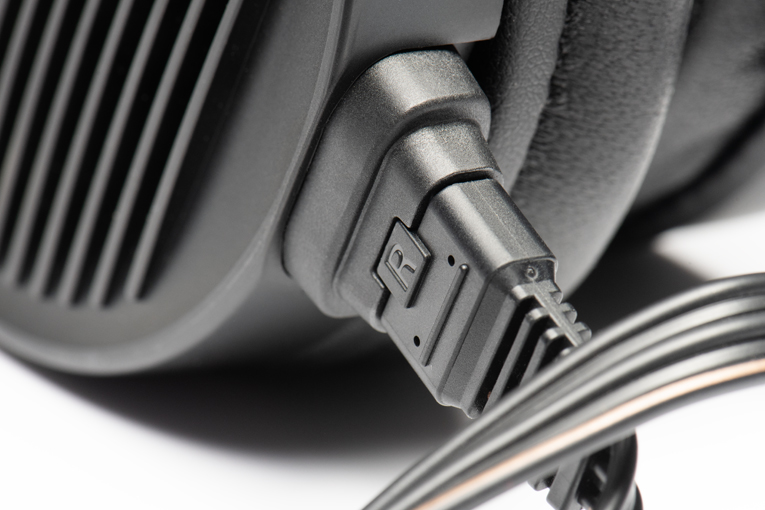
“Apoptose, Pt. 1,” from Floating Points’ 2019 album Crush (16/44.1 FLAC, Ninja Tune / Tidal), demonstrated to me that this Stax bundle is in a league of its own at this price point. Floating Points is the performing name of the English electronic-music producer Sam Shepherd. This complex track demands transducers with speed, punch, and effortless energy; it’s challenging for headphones and loudspeakers alike. The SR‑X1s performed very well, maintaining coherence in the synthesized drumbeats that pulsate on the far left and right, giving the track airiness and bass punch, while the keyboard in the center of the soundstage carries the main melody. The Stax headphones also exhibited impressive dynamics in the dramatic electronic effects that appear all over the soundstage throughout this track.
The French singer and multi-instrumentalist Vince Fenton, whose performing name is FKJ (French Kiwi Juice), is an artist whose creativity amazes me. His live performances feel like spontaneous song creation. Through the use of loops, he becomes a one-person band. But FKJ’s 2021 EP Just Piano (24/44.1 FLAC, Mom+Pop / Tidal) is different. “Sundays (Just Piano Version)” features FKJ playing only his piano, accompanied by birds chirping quietly at the edges of the soundstage. On this track, the SR‑X1s were highly revealing and delivered a great sense of acoustic space. I could hear FKJ pressing the pedals of his piano, followed by the convincing decay of his keystrokes and the reverberation through the room.
Comparison
I compared the Stax system to my reference setup—Audeze’s LCD‑2 Closed-Back headphones (US$899) and a Rupert Neve Designs RNHP Precision headphone amplifier. I connected the Rupert Neve amp to the SRM‑270’s RCA outputs using a pair of Shunyata Research Venom RCA cables, and enabled Roon’s preset EQ filters for my Audeze LCD-2 Closed-Back headphones.
The big Audezes have a completely different feel than the lighter Staxes. The earpads are larger and position the diaphragms farther from my ears compared to the SR‑X1s, which have shallower earpads that bring the diaphragms closer. Compared to the Stax headphones, the bass on the LCD‑2s was deeper and more substantial, but more relaxed. This difference was very noticeable when I listened to “Séance” from the Sinners soundtrack. The Audezes were much warmer-sounding; however, bass was less controlled compared to the SR‑X1s. The SR-X1s also performed better in terms of instrumental separation, and more effectively highlighted Blake’s distinct vocals. The sonic presentation was more open and livelier with the SR-X1s.
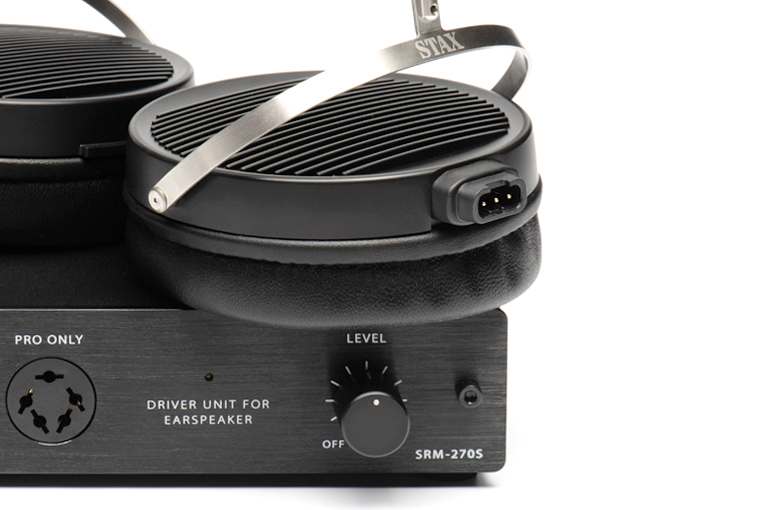
On “Desert Rose” from Galimatias’s 2024 album Lost Cargo (24/44.1 FLAC, Galimatias / Tidal), I immediately noticed that the soundstage was more constricted in both width and height on the Audeze planars compared to the SR‑X1 electrostats. The song begins with a trickle of water in the upper left of the soundstage, and with the LCD‑2 Closed-Back headphones, that trickle lacked the space and height I expect from this song. The SR‑X1s were a completely different story. The trickle was more vivid and had a texture that recreated the realism of flowing water, and the overall track had more air.
Conclusion
During my time with the Stax SRS‑X1000 system, I played a broad variety of music, including jazz and electronic. I was particularly enthralled with tracks that benefited from the electrostatic ’phones’ exceptional coherence and spaciousness. While the bottom end was punchy and full, these headphones may not be the best choice for those seeking deep rumbling bass. But I recommend this Stax bundle to anyone seeking a desktop-friendly headphone system with a neutral sound signature, punchy bass, transparent presentation, and excellent fit and finish.
. . . Killain Jones
Associated Equipment
- Headphone amplifier: Rupert Neve RNHP Precision
- Headphones: Audeze LCD‑2 Closed Back
- Music server: Innous Zen Mk3
- Streamer: Raspberry Pi 4
- Digital-to-analog converter: Chord Electronics Qutest
- Cables: Shunyata Research Venom (RCA)
- Power distributor/conditioner: Audioquest PowerQuest 3
Stax SRS‑X1000 electrostatic headphone system (SR-X1 and SRM-270S)
Price: US$980, CA$1398, £1095, €1250
Warranty: One year
Stax International
Room 2101, 21st floor, The L. Plaza,
367-375 Queen’s Road,
Central - Hong Kong
Phone: +852 2522 6989
Fax: +852 2522 1989
Email:
Website: www.staxheadphones.com





